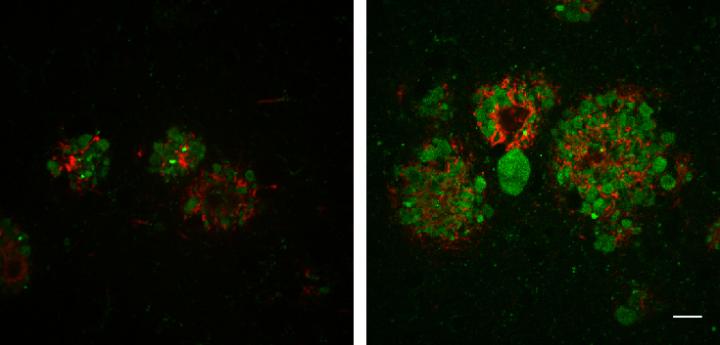![In the brains of mice with Alzheimer's disease, decreased levels of JIP3 (right) induce the formation of larger amyloid plaques (red) and increased numbers of swollen axons filled with lysosomes (green). [Gowrishankar et al., 2017/Journal of Cell Biology]](https://genengnews.com/wp-content/uploads/2018/08/Aug7_2017_Gowrishankar_MiceBrainAlzheimers3515196243-1.jpg)
In the brains of mice with Alzheimer’s disease, decreased levels of JIP3 (right) induce the formation of larger amyloid plaques (red) and increased numbers of swollen axons filled with lysosomes (green). [Gowrishankar et al., 2017/Journal of Cell Biology]
The accumulation of extracellular plaque is not the only neuropathological manifestation of Alzheimer’s disease. The degenerative condition is also marked by axonal swelling, which is caused by the intracellular accumulation of lysosomes. It is not clear, however, how axons, the parts of neurons that conduct electric impulses, come to be packed with lysosomes. Neither is it clear how lysosome accumulation may be related to disease. Both of these questions, however, are a little less puzzling now that Yale University researchers have completed a study on lysosome transport.
The researchers explored the possibility is that lysosomes promote plaque buildup, the aggregation of β-amyloid (Aβ) fragments, because some of the enzymes that generate Aβ by cleaving a protein called amyloid precursor protein (APP) accumulate in the swellings with the immature lysosomes.
When the researchers worked with a mouse model of impeded lysosome transport, they found that neurons that lacked a protein called JIP3 failed to transport lysosomes from axons to the cell body, leading to the accumulation of lysosomes in axonal swellings similar to those seen in Alzheimer's disease patients. The swellings also accumulated APP and two enzymes—called BACE1 and presenilin 2—that cleave it to generate β-amyloid. Neurons lacking JIP3 therefore generated increased amounts of Aβ.
Details of this work appeared August 7 in the Journal of Cell Biology, in an article entitled “Impaired JIP3-Dependent Axonal Lysosome Transport Promotes Amyloid Plaque Pathology.” By establishing a critical role of JIP3-dependent axonal lysosome transport in regulating amyloidogenic APP processing, the article supports a model “wherein Aβ production is amplified by plaque-induced axonal lysosome transport defects.” The article also suggests that developing ways to restore lysosome transport could represent a new therapeutic approach to treating the neurodegenerative disorder.
“JIP3 knockout mouse neuron primary cultures accumulate lysosomes within focal axonal swellings that resemble the dystrophic axons at amyloid plaques,” wrote the article’s authors. “These swellings contain high levels of amyloid precursor protein processing enzymes (BACE1 and presenilin 2) and are accompanied by elevated Aβ peptide levels. The in vivo importance of the JIP3-dependent regulation of axonal lysosomes was revealed by the worsening of the amyloid plaque pathology arising from JIP3 haploinsufficiency in a mouse model of AD.”
Essentially, the researchers removed one copy of the gene encoding JIP3—halving the amount of JIP3 protein—from mice that were already prone to developing Alzheimer's disease. These animals produced more Aβ and formed larger amyloid plaques, surrounded by an increased number of swollen axons.
“Collectively, our results indicate that the axonal accumulations of lysosomes at amyloid plaques are not innocent bystanders but rather are important contributors to APP processing and amyloid plaque growth,” said Shawn M. Ferguson, Ph.D., the article’s senior author and associate professor of cell biology at Yale University School of Medicine.
Genetic and environmental factors that impede lysosomal transport may therefore contribute to the progression of Alzheimer's disease. For example, traumatic brain injuries, which are thought to be significant risk factors for Alzheimer's disease, are known to disrupt transport along axons and induce axonal swelling.
“The identification of other proteins that function alongside JIP3 in regulating the axonal transport and maturation of lysosomes could ultimately lead to strategies to modulate the axonal abundance of lysosomes for therapeutic purposes,” noted Dr. Ferguson.



